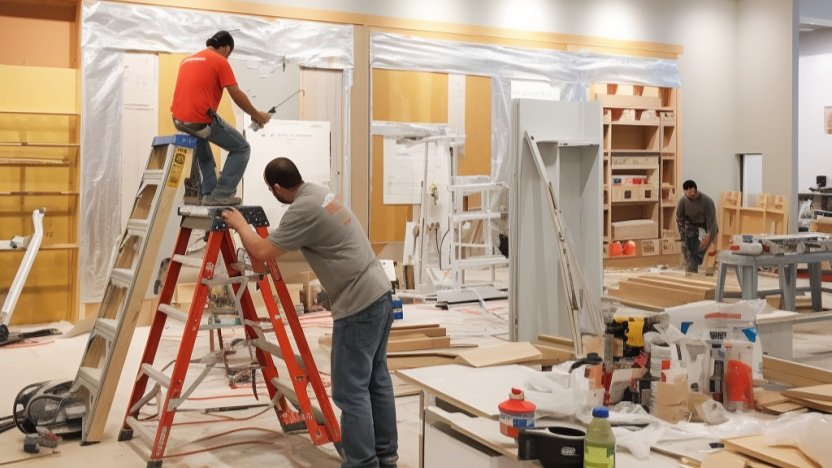Here’s What You Need to Know about Tenant Improvement Allowances
If you have ever started a search for commercial real estate, you likely know that it is almost guaranteed your new space will require some form of build-out.
Whether you are searching for retail, office, or industrial property, it is important to prepare for construction planning, as well as the costs that are associated with retrofitting a space.
Although looming construction costs can be intimidating, tenants have the option to push for a tenant improvement allowance in order to help mitigate the costs associated with a build-out.
What is a Tenant Improvement Allowance?
A tenant improvement allowance, also known as TI, TIA, or TA, is a pre-negotiated sum of money that a landlord will provide the tenant in order to cover all or a portion of construction costs.
TIA is typically expressed as a per square foot amount.
For example, if a landlord is offering $20.00 per square foot on a 2,500 square foot commercial space, the landlord has agreed to reimburse the tenant for $50,000 worth of construction costs.
While a tenant improvement allowance can certainly be applied to all build-out expenses, including labor, do not expect your TIA to also cover the cost of furniture or other moving/start-up costs not directly related to physical improvements to or alterations of the space.
How Do Tenant Improvements Work?
While you and your tenant rep broker may have negotiated a phenomenal tenant improvement allowance, do keep in mind that you will more than likely still need to have the capital to cover construction costs up front.
Once the work is complete, your landlord will then be able to reimburse you the negotiated allowance.
Returning to our previous example, if a landlord has agreed to a $50,000 improvement allowance, the tenant must still be prepared to use their own funds to initially cover construction.
The landlord will provide the tenant with the $50,000 allowance upon proof of completion, which may include receipts, lien waivers, etc.
What Is A Reasonable Tenant Improvement Allowance?
How large of a tenant improvement allowance you and/or your commercial broker are able to negotiate can vary depending on your business as well as other key points of the lease.
Be prepared to provide your potential landlord with financials for their review. These normally include two to three years of tax returns, as well as balance sheets, profit and loss analyses, and any other pieces of information that illustrate the numbers that support your business.
While this process is crucial to ensure being approved for a space, it also gives the landlord a better idea of how much tenant improvement costs they are willing to cover.
The Landlord May Initially Offer Tenant Improvements
Typically, since a tenant improvement allowance is somewhat of an investment and a risk, a landlord will be more likely to agree to a larger allowance due to strong credit and a business stability.
That being said, tenant improvements are still almost always negotiable.
For example, the tenant improvement allowance for unfinished shell space (no walls, gravel floor, etc.) will be much higher than that of a previously occupied and finished premises.
What if the Landlord Doesn’t Offer TIA?
If there is no initial TIA offering, do not hesitate to still present the discussion to a landlord.
If you are still having trouble obtaining a sufficient tenant improvement allowance, it may be time to discuss other negotiation strategies with your broker.
When you are asking for free rent or a delayed rent commencement, you may consider conceding some of this time in order to receive a larger allowance.
You may also be able to earn leverage if you are willing to commit to a longer term.
How to Calculate Tenant Improvement Allowance
The TIA amount can be calculated in several ways:
Fixed Amount: In some cases, the landlord may offer a fixed dollar amount as the TIA. This means you'll receive a predetermined sum to cover your eligible expenses. This fixed amount typically ranges from 25% to 150% of the total first year’s rental payments. So, for example, if your first year’s rent is $24,000, then you could expect to see anywhere from $6,000 to $36,000 in Tenant Improvements depending on the condition of the space, it’s age, etc.
Per-Square-Foot Basis: Many leases calculate TIAs based on a per-square-foot basis. This involves multiplying the agreed-upon per-square-foot allowance by the total square footage of the leased space. For example, if the TIA is $10 per square foot, and your space is 2,000 square feet, your TIA would be $20,000. Similar to the fixed amount example above, you can expect to see TIAs on a per-square-foot-basis range from 25% to 150% of the total price per square foot in rent.
Percentage of Total Costs: In certain situations, the TIA may be calculated as a percentage of the total eligible expenses. For instance, if the landlord agrees to cover 50% of your renovation costs, and your total eligible expenses are $40,000, your TIA would be $20,000. Your eligible expenses are expenses that will actually improve the physical structure of the building and excludes your business-specific FF&E. Some commonly eligible expenses include:
Plumbing and electrical work
HVAC upgrades
Flooring and ceiling improvements
Lighting enhancements
New walls or doors
Who Completes the Build-Out?
Unless the landlord has agreed to turn-key the space by assuming the responsibility of a full build-out, the tenant is almost always responsible for overseeing construction.
Of course, this will be done through your preferred contractor.
If you need help finding a general contractor, either your broker or even the landlord should be able to recommend at least a handful of trustworthy options.
You will also want to receive more than one bid to be sure you are receiving the quality of work you desire within a reasonable price.
Even if the landlord prefers a specific contractor be used, the tenant still has the opportunity to field competitive bids.
Finally, be sure to keep in mind that the landlord will almost always require some form of approval of the build-out plans.
How to Account for Tenant Improvement Allowance
Tenant improvement allowances play a crucial role in shaping the condition and functionality of a leased space. TIAs are funds allocated by the landlord to the tenant for making necessary improvements or renovations to the leased property.
However, how should they be accounted for depends on which party is actually paying for the tenant improvements.
For Tenants
Recognizing the TIA as a Liability: When a tenant is responsible for funding their improvements, the TIA provided by the landlord is initially recorded as a liability on the tenant's balance sheet. This reflects the obligation to use the funds for their intended purpose.
Amortization of the TIA: The tenant will gradually recognize the TIA as income over the lease term. This is typically done on a straight-line basis, with the total TIA amount divided by the total lease term. This accounting treatment reflects the reduction in the tenant's liability as they incur renovation expenses.
Expensing Renovation Costs: As the tenant incurs costs for the improvements, these expenses are recognized on their income statement as they are paid or capitalized and amortized over the lease term. This aligns with the principle of matching expenses with revenue.
Tracking Compliance with Lease Terms: It's crucial for tenants to ensure that their renovation costs are in compliance with the lease agreement. This includes adhering to any specific requirements or restrictions outlined in the lease.
For Landlords
Recording Tenant Improvement Allowances: When the landlord bears the cost of improvements, the TIA is typically recorded as an incentive or inducement on the tenant's balance sheet. It is not considered a liability since the tenant is not responsible for repaying it.
Amortization of Incentive: Tenants receiving a TIA from the landlord will recognize this incentive as a reduction of their rent expense over the lease term. This effectively reduces the overall occupancy cost for the tenant.
Accounting for Renovation Costs: Renovation costs incurred by the tenant are generally treated as expenses on their income statement as they are paid or capitalized and amortized over the lease term.
Understanding Tax Implications: Depending on local tax regulations, tenant improvement allowances may have tax implications for both tenants and landlords. It's advisable to consult with tax professionals to navigate these complexities.
The tenant improvements are typically an improvement to the property and landlords will have strict criteria for the types of improvements that must be made with that money. Landlords will receive tax benefits from providing these allowances, such as write offs and depreciation, since they are considered capital expenditures.
Alternatives to Build-Out Allowances
While a tenant improvement allowance can certainly be helpful in making a commercial space work, it may not be every tenant’s best option moving forward.
Turn-Key Renovations
As briefly mentioned, you may also ask your landlord to turn-key your space.
If your landlord agrees to such a request, this means the landlord will be responsible for overseeing construction and delivering the completed space to you as a condition of the lease.
So, instead of the tenant having to handle all of the construction after signing a lease, the landlord performs this work on a pre-determined timeline.
Some landlords or tenants may prefer this strategy, since it removes the burden from the tenant, who may not have construction experience, and the tenant won’t have to seek the landlord’s approval for each and every change they wish to make in the space since the landlord would be doing the work.
Rent Abatement
If you are less worried about covering construction costs, but more concerned with rent payments and build-out expenses overlapping, you can also focus less on the tenant improvement allowance and more on deferred rental payments.
As with all commercial real estate negotiations, tenant improvements are best approached with a concise goal and strategy.
Independent planning or discussing with your commercial broker will allow you to head into negotiations with confidence and clarity.

















You don’t see high-net-worth investors unclogging toilets or chasing down tenants for rent checks.
They’re not waking up at 2 AM to field maintenance calls—or spending weekends vetting property managers.
Why? Because they’ve figured out a smarter way to invest in commercial real estate: syndications.
Syndications allow everyday investors to own fractional shares of high-quality commercial properties—without doing any of the heavy lifting. You provide the capital. An experienced sponsor team does everything else. And you get a direct stake in the deal’s cash flow, equity growth, and tax benefits.
It’s how the top 1% scale their portfolios while protecting their time.
And it’s not just for institutions anymore.
In this post, we’re breaking down everything you need to know about CRE syndications:
How they work
Why they’re one of the most powerful tools for passive income
And how to spot the right deals (and the right partners) before you invest
If you’re ready to earn like an owner without the day-to-day stress, this is the strategy you’ve been looking for.